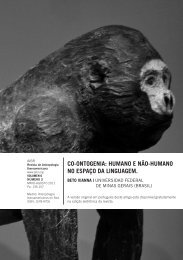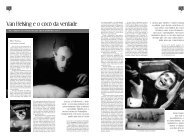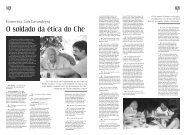Merleau-Ponty, 1964. Eye and mind. - Biolinguagem
Merleau-Ponty, 1964. Eye and mind. - Biolinguagem
Merleau-Ponty, 1964. Eye and mind. - Biolinguagem
- No tags were found...
You also want an ePaper? Increase the reach of your titles
YUMPU automatically turns print PDFs into web optimized ePapers that Google loves.
see the visible. The h<strong>and</strong> pointing toward us in The Nightwatch is truly there only when<br />
we see that its shadow on the captain's body presents it simultaneously in profile. The<br />
spatiality of the captain lies at the intersection of the two perspectives which are<br />
incompossible <strong>and</strong> yet together. Everyone with eyes has at some time or other witnessed<br />
this play of shadows, or something like it, <strong>and</strong> has been made by it to see things <strong>and</strong> a<br />
space. But it worked in them without them; it hid to make the object visible. To see the<br />
object, it was necessary not to see the play of shadows <strong>and</strong> light around it. The visible in<br />
the profane sense forgets its premises; it rests upon a total visibility which is to be<br />
recreated <strong>and</strong> which liberates the phantoms captive in it. The moderns, as we know, have<br />
liberated many others; they have added many a muted tone to the official gamut of our<br />
means of seeing. But the interrogation of painting in any case looks toward this secret<br />
<strong>and</strong> feverish genesis of things in our body.<br />
And so it is not a question asked of someone who doesn't know by someone who does—<br />
the schoolmaster's—question. The question comes from one who does not know, <strong>and</strong> it<br />
is addressed to a vision, a seeing, which knows everything <strong>and</strong> which we do not make,<br />
for it makes itself in us. Max Ernst (with the surrealists) says rightly, "Just as the role of<br />
the poet since [Rimbaud's] famous Lettre du voyant consists in writing under the dictation<br />
of what is being thought, of what articulates itself in him, the painter's role is to<br />
circumscribe <strong>and</strong> project what is making itself seen within himself. " 8 The painter lives in<br />
fascination. The actions most proper to him—those gestures, those tracings of which he<br />
alone is capable <strong>and</strong> which will be revelations to others because they do not lack what he<br />
lacks—to him they seem to emanate from the things themselves, like figures emanating<br />
from the constellations.<br />
Inevitably the roles between the painter <strong>and</strong> the visible switch. That is why so many<br />
painters have said that things look at them. As Andre March<strong>and</strong> says, after Klee: "In a<br />
forest, I have felt many times over that it was not I who looked at the forest. Some days I<br />
felt that the trees were looking at me, were speaking to me…. I was there, listening…. I<br />
think that the painter must be penetrated by the universe <strong>and</strong> not want to penetrate it…. I<br />
expect to be inwardly submerged, buried. Perhaps I paint to break out. " 9<br />
We speak of "inspiration," <strong>and</strong> the word should be taken literally. There really is<br />
inspiration <strong>and</strong> expiration of Being, respiration in Being, action <strong>and</strong> passion so slightly<br />
discernible that it becomes impossible to distinguish between who sees <strong>and</strong> who is seen,<br />
who paints <strong>and</strong> what is painted. We say that a human being is born the moment when<br />
something that was only virtually visible within the mother's body becomes at once visible<br />
for us <strong>and</strong> for itself. The painter's vision is an ongoing birth.<br />
In paintings themselves we could seek a figured philosophy 10 of vision—its iconography,<br />
perhaps. It is no accident, for example, that frequently in Dutch paintings (as in many<br />
others) an interior in which no one is present is "digested" by the "round eye of the mirror.<br />
" 11 This prehuman way of seeing things is emblematic of the painter's way. More<br />
completely than lights, shadows, <strong>and</strong> reflections, the mirror image anticipates, within<br />
things, the labor of vision. Like all other technical objects, such as tools <strong>and</strong> signs, the<br />
mirror has sprung up along the open circuit between the seeing <strong>and</strong> the visible body.<br />
Every technique is a "technique of the body," illustrating <strong>and</strong> amplifying the metaphysical<br />
structure of our flesh. The mirror emerges because I am a visible see-er, because there is<br />
a reflexivity of the sensible; the mirror translates <strong>and</strong> reproduces that reflexivity. In it, my<br />
externality becomes complete. Everything that is most secret about me passes into that<br />
face, that flat, closed being of which I was already dimly aware, from having seen my<br />
reflection mirrored in water. Schilder observes that, smoking a pipe before a mirror, I feel<br />
the sleek, burning surface of the wood not only where my fingers are but also in those<br />
otherworldly fingers, those merely visible ones inside the mirror. 12 The mirror's phantom<br />
6









